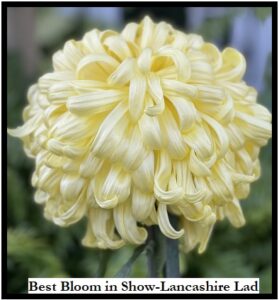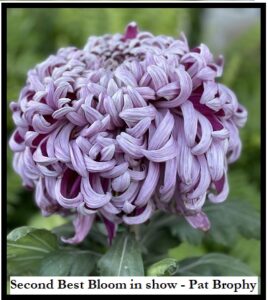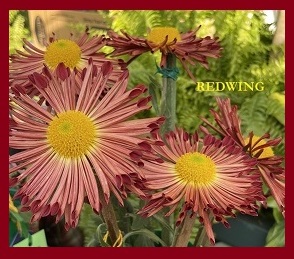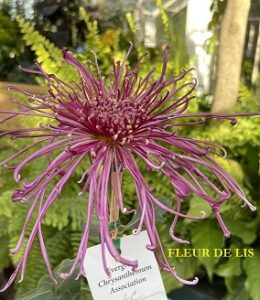EVERGREEN CHRYSANTHEMUM ASSOCIATION
Seattle, Washington
Ecamumclub.org
Jim Anshutz, Secretary
ANNUAL GARDEN TOUR AND POT LUCK PICNIC
AUGUST 14TH, 2011
2011 GARDEN TOUR – The annual ECA garden tour and Picnic is scheduled for Sunday, August 14th.
This year’s tour features a special tour of Seattle’s Kubota Gardens (9 a.m.)—bring water since there are no drinking fountains); a tour of Bob Ewing’s mums and gardens at Wesley Gardens (11-12) and concludes at Mark and Janet Ross’s home where we’ll tour Mark Ross’s garden and enjoy hamburgers and hot dogs as well as pot luck dishes brought by our members (please bring your favorite folding chair if you have one since the seating is needed for the picnic). Tour directions are on pages 3-4.
As of our July meeting, 21 persons had signed up for the tour/potluck. Anyone needing a ride or who wishes to carpool, please call or email Steve Backstrom. The potluck signup sheet (salad, main dish or dessert) as of August 1 is on the last page of the Tour Directions.
Sad News
I’m sorry to report that Jill Aldrich lost her mother who passed away on June 15. I sent a card to Jill on behalf of the Club and I hope you will also express condolences to Jill.
Aki Matsuri:
The 2011 Japanese cultural heritage festival Aki Matsuri will be held at Bellevue College on Saturday, Sept 10th & Sunday, Sept. 11 at Bellevue College. (Go to www.enma.org to see information about this year’s event and directions.). This event is well attended and has been a good way to recruit Club members, help make our spring plant sales successful (we have people address post cards notifying them of our sale) and helps publicize our fall show.
Jim Anshutz has helped organize this event the last two years but will be out of town this year so we need a volunteer to take charge of recruiting and scheduling volunteers for the event, to help set up our booth (done Friday afternoon, September 9th–). Setting up the booth involves getting our Club easels/picture boards, postcards notifying addressees of our Spring sale, membership materials, plants/blooms for the two tables (with chairs) that Aki Masuri folks provide for us.
We also need volunteers to staff our booth or Saturday September 10th from 10 a.m, – 6 p.m. (as of now, only Tashiye Goff has volunteered for a Saturday shift) and volunteers for Sunday shifts 10-4:30 and then a volunteer to take down the booth Sunday afternoon (after 4 p.m.). We’ll also need members to provide blooms/plants for our booth. Last year Bob Ewing and Don Stark had the postcard notices, easels and club pictures and several members contributed blooms and plants. Hopefully we can discuss this at our picnic meeting and we’ll have one last ECA Club meeting on September 8 –the day before set up.
We expect that there will be lots of publicity for this year’s event as people collect monies for disaster relief and strong attendance is expected.
PLANT CULTURE and SUPPLIES: – Place orders for specific items with Mark Ross. Cultural recommendations are attached for August and September. It is time to consider your sheltering options for September as we move to the latter part of the growing season.
Other Member Notices
Happy Anniversary 55th for Bob and Mary Lou Ewing. August 4th
CONGRATULATONS
Happy Birthday to Ed Pawlowski.
Upcoming Puyallup Fair:
Chrysanthemums are featured on Saturday, September 24, 2011. Go to the Fair’s web site HYPERLINK “http://www.thefair.com” www.thefair.com . If you are interested in displaying at the fair, go to web site, click on Fair, then Exhibit Entries (bottom left side of page), and then click on Floral. You may be required to make online entry for by September 7 (if their online instructions are accurate).
As a reminder, please send any email address or postal address changes to Jim Anshutz. To receive future monthly notices by email only rather than US mail, please send an e-mail to Jim.
Directions – Sunday, August 14, 2011 Garden Tour
Stop 1 –Meet at 9 a.m. at the parking lot of Kubota Gardens. Their website has directions and has information about the history of the garden and other information.
Please bring some water for yourself since this park doesn’t have drinking fountains. The garden is located at Renton Avenue S. and 55th Avenue South in the Rainier Beach neighborhood of South Seattle (the street address is 9817 55th Ave S. Seattle,Wa.). There will be two docents to lead the tour.
Directions From the North
On I-5, leave the freeway at Pacific Highway South/East Marginal Way, Exit 158
Turn left toward Martin Luther King, Jr. Way; continue up the hill on Ryan Way
Turn left on 51st Avenue South
Turn right on Renton Avenue South
Turn right on 55th Avenue South to parking lot
Directions From the South
On I-5, leave the freeway at Martin Luther King Jr., Exit 157.
Stay on Martin Luther King, Jr. Way
Turn right on Ryan Way
Turn left on 51st Avenue South
Turn right on Renton Avenue South
Turn right on 55th Avenue South to parking lot
Stop 2 – Wesley Gardens
We expect to meet at Wesley Gardens at around 11 A.M. We’ll take refreshments at Bob and Mary Lou Ewing’s cottage and then take a tour of their garden the see Bob’s main mum garden which is close by.
Stop 3 – Potluck Picnic Location – Mark and Janet Ross’s House. We expect to arrive around 12:30.
August 14 Potluck Signup Sheet from July Meeting
Number
Attending Bringing
Steve Backstrom 2 Desert
Chris Brookes 2 Salad
Sydney Ogilvie 2 Salad
Richard Pozniak 2 still deciding
Don Stark 2 Main dish
Mary Nolting 1 Desert
Ann Schreibe 1 Salad
Bob Ewing 2 Main Dish
Becky Cox Desert
Ronnie Elliott 2 Salad, desert
Nancy Halleen Salad, desert
Randal Tanabe 1 Main dish
Joan O’Sullivan 1 Salad
Janet Anderson 1 Salad
EVERGREEN MUM CLUB Rev Aug 3, 2010 drs
Revised feeding Program for Bloom Cycle
By mid August, after the buds are taken, it’s time to revise our feeding program. We will be switching to new formulation that is much higher potash content and reducing the amount of feed through the bloom cycle. Here’s the plan:
1. As soon as the bud has been taken, reduce your feeding level to ½ what you have been using. If you have been feeding really heavily, you might have to reduce further. A good position at this time is ½ tsp per gal of water once a week.
2. Starting mid Aug. we do two things. First feed each pot ½ tsp granular potash and 2 weeks later repeat with 1/4 tsp potash.
-When the buds break in late Aug or Sept, it’s time to change to a new fertilizer formulation with higher potash concentration. This will harden off the plants and promote better bloom development. We have been unable to find the old standby’s 15-10-45 or 20-5-30 so here’s the new recommendations for late feeding.
Liquid feeding formulation
– 1/2 tsp of the standard 20-9-20 plus ¼ tsp Sulfate of potash fertilizer per gallon of water.
Note:, the sulfate of potash doesn’t dissolve readily, so you might try mixing it with a small amount of hot water and letting it set overnight.
-Watering: The plants wont require as much water during this cycle, so you should apply only a pint of water per pot. Likewise, only a pint of your liquid fertilizer mix at a time
– after the bloom petals have emerged and dropped 1 ½ to 2 inches you may want to increase the feed by feeding more often than once a week., but use caution because you can blow the blooms with too much fertilizer
AUGUST TO DO LIST – Revised July 2005 by Don Stark and Bob Walker
August is a major growing month. Continue with the watering, feeding, and pest control programs noted in the July newsletter. l The appearance of bud color, especially for the early cultivars, signals a shift to the late season feeding program. Flush the pots at least once during the month to reduce the accumulation of fertilizer salts in the pot. Disbudding is the primary cultural activity for the first half of August. Stake and reduce the number of laterals as the buds appear and are secured. Experience suggests there is no way to get too much support for laterals and blooms. Top-dress the plants with fresh potting mix to assure maximum plant growth now and new shoots for next season.
Staking and Lateral Control
Surplus laterals are removed as the buds are firmly established for all varieties with the exception of incurves (classes 3, 13, and 23) and some intermediate types (classes 5, 15, and 25), which are culled in early September. With 2 ½ months until the ECA show, it may be conservative to wait a few more weeks for the final reduction in the event of bug damage, wind, or accidents.
Reduce the number of laterals to the final count as listed below. For early varieties follow last number, ex. #14 and #24 use #4.
For #1 and #2 cultivars, carry 1 or 2 laterals.
For #3 cultivars, carry up to 5 laterals, cull to 3 in Sept.
For #4 cultivars, carry 2 or 3 laterals.
For #5 cultivars, carry 2 to 5 laterals.
All laterals should be individually staked Fasten the laterals with “twist’ems”. If the laterals are not staked or otherwise supported, they break off with rain or breeze and also grow crooked, making the resulting bloom difficult or impossible to enter in shows.
Blooms and Bloom Support
Watch for buds and secure them as they appear. Most buds appear by August 15. Look for “rabbit-ear” leaves below the bud and laterals forming at leaf axils. As the bud reaches about ¼ inch, or the size of a small pea, it should be secured by removing the ring of side buds and the other side shoots that may appear in the leaf axils below. Keep those new laterals removed. This grooming of the selected laterals will require regular and sometimes daily attention.
Prepare strips of wood 16-18 inches long and 3/8” wide made from shingles, shakes, or ¼” plywood. Stain them green preferably. These are used to support each bloom and are secured with two “twist’ems”. Place them on the bud/lateral as the bud over-grows the stakes to protect the lateral and bud, to keep the lateral growing straight, to support the bloom, and keep the bud horizontal. A “cocked” bloom will never win a blue ribbon.
Feeding & Top-Dressing
Top-dress the pots in early August and again when the buds show color, about September 1-15. Put about 1 handful of compost or Soil less mix on the surface of the pot and level it each time you top-dress.
Water thoroughly when you water and then almost dry out the plant before watering again. If plants are yellow, first try drying them out. If drying out fails, feed ½ teaspoon Epsom salts per plant or carefully use of one of the liquid iron solutions.
Continue fertilizing until buds appear with the mid season fertilizer program as described in the July to-do list.
Flush the pots once per month to prevent fertilizer salts build-up.
The appearance of the bud especially for the early cultivars, also signals a shift to the late season feeding program. When the buds appear, stop or reduce feeding ½ strength for 1-2 weeks and water the plants more sparingly. At this stage it’s time to change the feeding program to a late season fertilizer. Either switch to a high potash fertilizer (15-11-29) or continue with the 20-10-20/20-9-20+ fertilizer and add approximately15 % by volume of Murate of Potash. In either case continue to fertilize at ½ to 2/3tsp per gal of water.
Pest Management and Housing
Review your pest management program every two weeks and correct as necessary. Have your plants free of aphids and fungus before the blooms are set to open. Aphids in blooms are cause for disqualification at shows.
Spray every two weeks with a fungicide or an insecticide/fungicide if not using Marathon as an insecticide.
Watch for and destroy earwigs. They wreck blooms when they get inside.
Finally, anticipate your housing needs and start preparations to get your show flowers under cover by the first or second week of September.
Stark, 4 July 2005
SEPTEMBER TO DO LIST – (adapted from Don Stark 9/98 notes)
Once the buds have broken the membrane and some petal tips are showing, it is time to get the pots into or under some kind of shelter. The basic idea is to protect the blooms from rain and dew. If rain or dew is present when the sun strikes, you will almost certainly burn the florets. Shelters come in a variety of sizes, names, and shapes including porches, large overhanging eaves, garages, greenhouses, and temporary wood and plastic structures.
Sheltering Plants During the Bloom Cycle Starting September 1
Shelter requirements are daytime light (though it can be shady), ventilation, and temperature control.
Maximum temperature should be kept below 80 degrees F if possible. Above that temperature the probability of bloom damage due to petal rot is high. If the shelter is exposed to too much sun in the early Sept days, the temperature within the shelter can skyrocket.
Big fans keep the air moving and the temperature down. Fans also hopefully can bring air from a shady side of the shelter to cool the overall area as well.
Lining the inside of the shelter with old sheets or muslin will also reduce the heat and filter the sunlight.
Bring Pots Into Cover
Wash the pots to get rid of the crud and residue from the growing area.
Pick off old dead and damaged leaves (mostly at the bottom of the plant) that harbor pests and fungus.
Spray the plant with a fungicide and insecticide before taking to the shelter.
Watch for and destroy earwigs. They wreck blooms when they get inside.
Top-dress the pots again. Put about ½ to ¾” of the 9-Inch mix or Soilless mix on the surface of the pot and level it. Top-dressing the plants helps finish plant growth now and also promotes shoots on the plant stools for our next growing season.
Optionally, add ¼ teaspoon FeSo4 to enhance color. Do not add to plants with white or yellow blooms.
Add ¼ teaspoon of Potash to help harden off the plant and keep the blooms from being too soft.
Plant Clean Up and Cut Back to Final Lateral Count
As the plant goes to shelter, if not already done, cut back to the final lateral count selecting the best overall laterals. For #1’s keep 1 or 2 blooms per plant, #2’s keep 2 blooms per plant, #3’s and others excluding specimen plants keep 2 to 5 blooms per plant.
Stake and tie up the selected laterals and add support shingles for the blooms as you house the plant.
Remove or pick off the side laterals on the selected stems.
Fertilizing & Watering
For late season fertilizing, reduce fertilizer to ½ strength for 2-3 weeks. After the petals start to fall, gradually increase feed. Switch to a higher potash fertilizer along the lines of a 15-10-30 or other bloom feeder fertilizer and go lightly.
Watering is different at this stage as the plants are kept a little dryer at this stage. Water plants more sparingly, using about 1 pint per watering. Do not water when the temperature exceeds 75F.
There are two schools of thought as to the best time of day to water. Previous year cultural notes recommend to water in the evening as the day is cooling down to help avoid sending the plant sap to the blooms in heat of day and blowing out or cracking the bloom neck. Bob Walker recommends watering in the early part of the day.
Water/fertilize from a bucket using a 1-pint jar or similar small container. Do not use the hose and spread water everywhere on the shelter floor. Keep the finishing area dry and clean.




